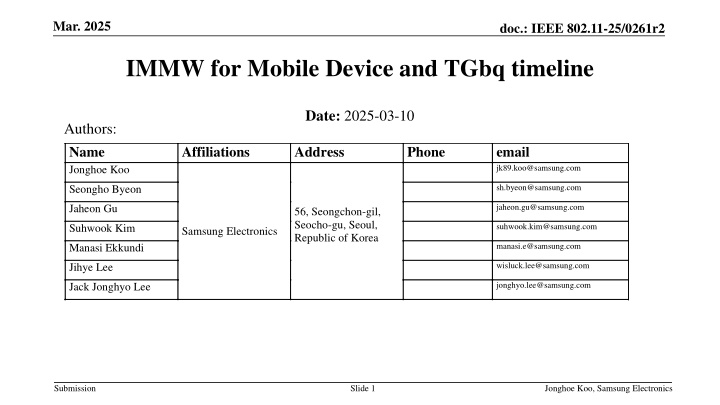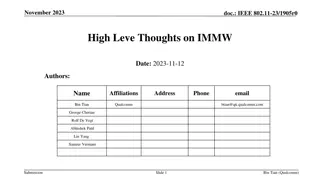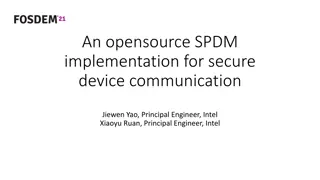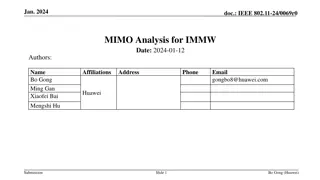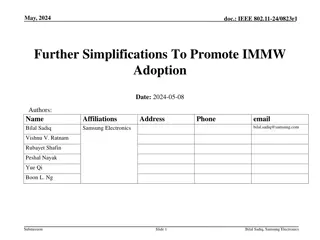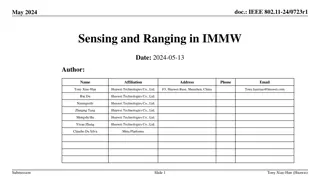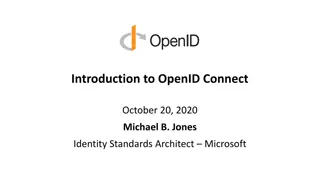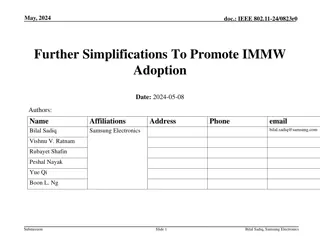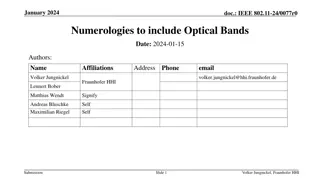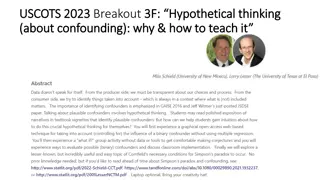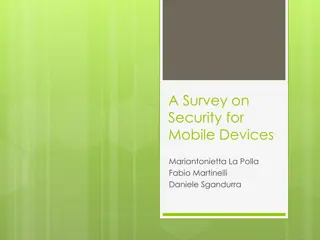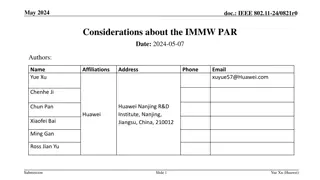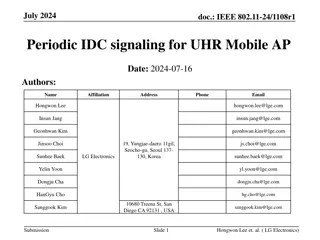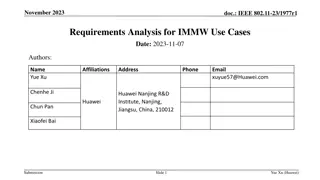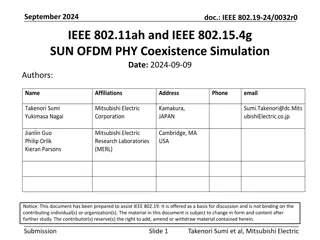IEEE 802.11-25/0261r2 IMMW for Mobile Device and TGbq Timeline
IEEE 802.11-25/0261r2 introduces IMMW project focusing on non-standalone operation in the 42-71 GHz range for mobile devices. Leveraging existing standards, the project aims to support new applications like augmented reality and ensure cost-effective operations. Detailed discussion on specifications, considerations, and consumer device use cases is provided.
Uploaded on Apr 13, 2025 | 4 Views
Download Presentation

Please find below an Image/Link to download the presentation.
The content on the website is provided AS IS for your information and personal use only. It may not be sold, licensed, or shared on other websites without obtaining consent from the author.If you encounter any issues during the download, it is possible that the publisher has removed the file from their server.
You are allowed to download the files provided on this website for personal or commercial use, subject to the condition that they are used lawfully. All files are the property of their respective owners.
The content on the website is provided AS IS for your information and personal use only. It may not be sold, licensed, or shared on other websites without obtaining consent from the author.
E N D
Presentation Transcript
Mar. 2025 doc.: IEEE 802.11-25/0261r2 IMMW for Mobile Device and TGbq timeline Date: 2025-03-10 Authors: Name Jonghoe Koo Affiliations Address Phone email jk89.koo@samsung.com sh.byeon@samsung.com Seongho Byeon Jaheon Gu jaheon.gu@samsung.com 56, Seongchon-gil, Seocho-gu, Seoul, Republic of Korea Suhwook Kim suhwook.kim@samsung.com Samsung Electronics Manasi Ekkundi manasi.e@samsung.com Jihye Lee wisluck.lee@samsung.com Jack Jonghyo Lee jonghyo.lee@samsung.com Submission Slide 1 Jonghoe Koo, Samsung Electronics
Mar. 2025 doc.: IEEE 802.11-25/0261r2 Introduction (IMMW PAR/CSD) Scope of the project Non-standalone operation in 42-71 GHz using single-user OFDM 11bq device is required to support at least one of sub-7.25 GHz bands Multi-Link Operation (MLO) defined in sub-7.25 GHz (i.e., 11be) to support non-standalone operation in 42-71 GHz leverage or reuse existing PHY/MAC defined for sub-7.25 GHz bands, e.g., SU PPDU format and MAC frames, and define BW mode operating in non-overlapping channels Need for the project Demands of new applications (e.g. augmented and virtual reality, proximity ranging and sensing) both in terms of throughput, latency bounds and accuracy even in in the densest environments Cost effective manner is achieved by enabling non-standalone operation in 42-71 GHz bands Submission Slide 2 Jonghoe Koo, Samsung Electronics
Mar. 2025 doc.: IEEE 802.11-25/0261r2 IMMW SG Discussion Summary Considerations Specific values or mentions in IMMW SG contributions 11ad/11aj/11ay Reused and modified sub 7GH MAC 1. Leverage 11be/11bn Multi-Link Operation [1,2,6,8,15] 2. Non-standalone IMMW link [1,2,8,15] 3. Leverage other 11be MAC features [1,8,15] - Reuse and modified sub 7GHz PHY Upclocking [2,5,13], processing capabilities [3] - Single-User/Multi-User Single-User [1,2,6,8,19] Multi-User for the next release [2] SU (11ad), MU (11ay) Bandwidth (BW) Min 80/160 MHz (160 for AP) [2] Min 160 MHz & [160, 640] range [12], [160, 1280] range [6] 320, 640 MHz [1], Min 320 MHz & [320, 2560] range [7] Current support channel width in sub 7GHz [2,8] 2.16 GHz (11ad/11ay), 540/1080 MHz (11aj), Sub-carrier spacing 312.5 kHz x 8 = 2.5 MHz [6] 5.12 MHz (11ay) Modulation Up to 16 QAM [1] Up to 64 QAM [5] , up to 256 QAM [7] SC only 64 QAM (11ad/11ay) Number of Spatial Streams (NSS) 1 [1] 2 [2,11], SU-MIMO [5] up to 2 [19] or 4 [7] 1 (11ad), SU/MU-MIMO (11ay) Throughput Depending on max bandwidth, NSS, and modulation scheme 8.1/ 37.9 Gbps (11ad/11ay) Latency Low latency (<10ms) for IMMW use cases (e.g., XR/VR applications) [10] - Sensing/Localization Other related TG will expand 11bq amendment [8,19], 11bk/az/bf as baseline [17,19] - Submission Slide 3 Jonghoe Koo, Samsung Electronics
Mar. 2025 doc.: IEEE 802.11-25/0261r2 Use case and Considerations on Consumer Mobile Device Use Case High throughput hotspot Screen mirroring: up to 8K video mirroring with wire-equivalent latency AR/VR application with wire-equivalent latency and proximity/gesture detection [3] Submission Slide 4 Jonghoe Koo, Samsung Electronics
Mar. 2025 doc.: IEEE 802.11-25/0261r2 Use case and Considerations on Consumer Mobile Device Further considerations Small form-factor size with a single antenna for mmW preferred for consumer device Latency reduction is important to support AR/VR application with low latency traffic (e.g., 10 ms with 99- percentile wireless delay) [4,10] Throughput bottleneck due to Application Processor (e.g., 5 Gbps with single-core) or PCIe interface capability Some moderate throughput (< 5 Gbps IMMW link throughput) may be enough [1,3] User experience: low battery drain rate [8,10,16], reduced batter/device heating Absolute heat reduction is more important than J/bit metrics. High throughput or active usage of mmW Tx chain can increase heat, which may be better to be avoided With the benefit of small form-factor and reduced battery heating, DL-only operation in mmW (UL TX, e.g., Ack tx, in sub-7GHz) may be considered as one of implementation options [18] In consideration of hand grip loss and human body disturbance, user s mobility, a robust (re)transmission protocol design is required Submission Slide 5 Jonghoe Koo, Samsung Electronics
Mar. 2025 doc.: IEEE 802.11-25/0261r2 TBDs To be determined in consideration of practical IMMW use case, power consumption, cost, target throughput, target latency, etc. [11] Baseline sub-7GHz PHY to reuse for IMMW: 11ac, 11ax, or 11be Minimum bandwidth: upclocking factor Mandatory bandwidth range, Maximum bandwidth Mandatory number of spatial streams (NSS), Maximum NSS Maximum modulation Submission Slide 6 Jonghoe Koo, Samsung Electronics
Mar. 2025 doc.: IEEE 802.11-25/0261r2 Other TGs Timelines (as a reference) PAR approved First TG meeting WG Letter Ballots (D1.0) SA Ballot (D3.0/4.0/5.0) Final 802.11 WG Approval RevCom Approval PAR 11ad Very High Throughput 60GHz 2008-12-10 2010-10-24 2012-01-05 2012-07-01 2012-10-23 11ay Next Generation 60GHz 2015-03-26 2018-01-07 2020-01-09 2020-11-01 2021-03-01 11bf WLAN Sensing 2020-09-25 2020-08 2023-03-02 2024-06-12 11bh Randomized and Changing MAC Addresses 2021-02-10 2023-07-01 2024-05-09 2024-07-01 11bi Enhanced Data Privacy 2021-02-10 2025-01 11bk 320 MHz Positioning 2022-12-03 2023-12-28 2024-11-10 11bp Ambient Power Communication 2024-03-19 2024-05 2026-02 2027-08 2028-01 2028-05 from first TG meeting to D1.0: 1-3 years from D1.0 to 11 WG approval: 1-2 years Submission Slide 7 Jonghoe Koo, Samsung Electronics
Mar. 2025 doc.: IEEE 802.11-25/0261r2 Proposal: TGbq Timeline Adjustment TGbq timeline needs to be adjusted and PAR extension may be required considering the start date of TGbq (Feb. '25), sufficient technical discussions period (1-2 years), the practical letter ballot period (1-2 years), and SA ballot period (0.5 year) Roughly we have three options, i.e., Option 1 (maintaining PAR timeline, the expected completion time: Mar. 2027), Option 2 (+ 1 year, e.g., a timeline for compact spec. feature set, the expected completion time: Apr. 2028), and Option 3 (+ 2 years, e.g., a timeline for big spec. feature set, the expected completion time: Apr. 2029) PAR/CSD approved in WG (Jul. '24) IMMW SG (Nov. '23) Initial SA Ballot (D4.0) (Jul. '26) Submittal to RevCom (Mar. '27) D1.0 D0.1 First TGbq (Feb. '25) 34 contributions discussed 8 month 16 month Option 1 (PAR timeline) Mar. '25 (now) Submittal to RevCom (Mar. '28) D1.0 (Jul. '26) D0.1 D4.0 (Jul. '27) (Jan. '26) 6 month 12 month 10 month 6 month Option 2 (+1 year) Submittal to RevCom (Mar. '29) D0.1 (Jul. '26) D4.0 (Jul. '28) D1.0 (Jul. '27) 16 month 12 month 6 month 12 month Option 3 (+2 years) Break 2029 2028 2027 2024 2025 2026 Submission Slide 8 Jonghoe Koo, Samsung Electronics
Mar. 2025 doc.: IEEE 802.11-25/0261r2 Conclusion Various technical discussions have been studied in the IMMW SG, and now specific upper limits and mandatory sets of spatial stream, bandwidth, modulation, etc. need to be determined in consideration of target throughput and latency that support practical IMMW use cases We need a more realistic and reasonable timeline for TGbq in consideration of the other TGs timelines, sufficient technical discussion period and comment resolution period D0.1 Discussion on target performance metrics and which specific MAC/PHY features we can reuse for TGbq to achieve them MAC enhancement to support Multi-Link Operation for non-standalone mmW link D1.0 D4.0: comment resolution period (it typically takes 1-2 years) Submission Slide 9 Jonghoe Koo, Samsung Electronics
Mar. 2025 doc.: IEEE 802.11-25/0261r2 Reference [1] 11-23/1905r0, High Level Thoughts on IMMW, Bin Tian, Qualcomm [2] 11-23/1968r0, Discussion on general direction of integrated mmWave, Ming Gan, Huawei [3] 11-23/1974r0, Flexible sub-7GHz and mmWave Integration in IMMW, Yanchun Li, Huawei [4] 11-23/1977r1, Requirements Analysis for IMMW Use Cases, Yue Xu, Huawei [5] 11-23/1991r0, Discussion on Enabling MIMO in IMMW, Mengshi Hu, Huawei [6] 11-23/2004r0, Technical scope proposal, Laurent Cariou, Intel [7] 11-23/1878r1, High-level Design Considerations in IMMW, Jianhan Liu, MediaTek [8] 11-23/1819r1, Integrated mmWave Design Considerations, Claudio da Silva, Meta [9] 11-23/2102r1, IMMW Multi-Link Operation for mmWave Wi-Fi Sensing, Saira Rafique, Vestel [10] 11-24/0066r0, Discussion on Target Objectives for IMMW, Eunsung Park, LG Electronics [11] 11-24/0069r0, MIMO Analysis for IMMW, Bo Gong, Huawei [12] 11-24/0076r0, Comparison of OFDM and EDMG SC Waveform, Thomas Handte, Sony [13] 11-24/0133r0, Channel raster considerations for 60GHz band in IMMW, Micky Mehta, Pharrowtech BV [14] 11-24/0167r0, Discussion on Bandwidth Issue in IMMW, Yue Xu, Huawei [15] 11-24/0459r0, Multi-Link Operation for IMMW, Insun Jang, LG Electronics [16] 11-24/0471r0, Considerations on Power Consumption, Sang Kim, LG Electronics [17] 11-24/0723r1, Sensing and Ranging in IMMW, Tony Xiao Han, Huawei [18] 11-24/0823r1, Further Simplifications to Promote IMMW Adaoption, Bilal Sadiq, Samsung Electronics [19] 11-24/1104r1, Thoughts on IMMW for the Industry Use, Yue Xu, Huawei Submission Slide 10 Jonghoe Koo, Samsung Electronics
Mar. 2025 doc.: IEEE 802.11-25/0261r2 Straw Poll #1 Do you agree with extending the timeline since the current PAR timeline is considered unrealistically tight? Submission Slide 11 Jonghoe Koo, Samsung Electronics
Mar. 2025 doc.: IEEE 802.11-25/0261r2 Straw Poll #2 Which of the following options do you think a realistic and reasonable timeline for TGbq? Option 1) the expected completion time (submittal to RevCom): Mar. 2027 This option aligns with the timeline in the PAR Expected milestone: D1.0 (late '25 or early '26), D4.0 (Jul. '26) Option 2), the expected completion time: Mar. 2028 Expected milestone: D0.1 (Jan. '26), D1.0 (Jul. '26), D4.0 (Jul. '27) One year of technical discussions to get D0.1 Option 3), the expected completion time: Mar. 2029 Expected milestone: D0.1 (Jul. '26), D1.0 (Jul. '27), D4.0 (Jul. '28) One and a half years of technical discussions to get D0.1 [Note 1] If straw poll #1 is passed, then option 1 is not valid. Submission Slide 12 Jonghoe Koo, Samsung Electronics
